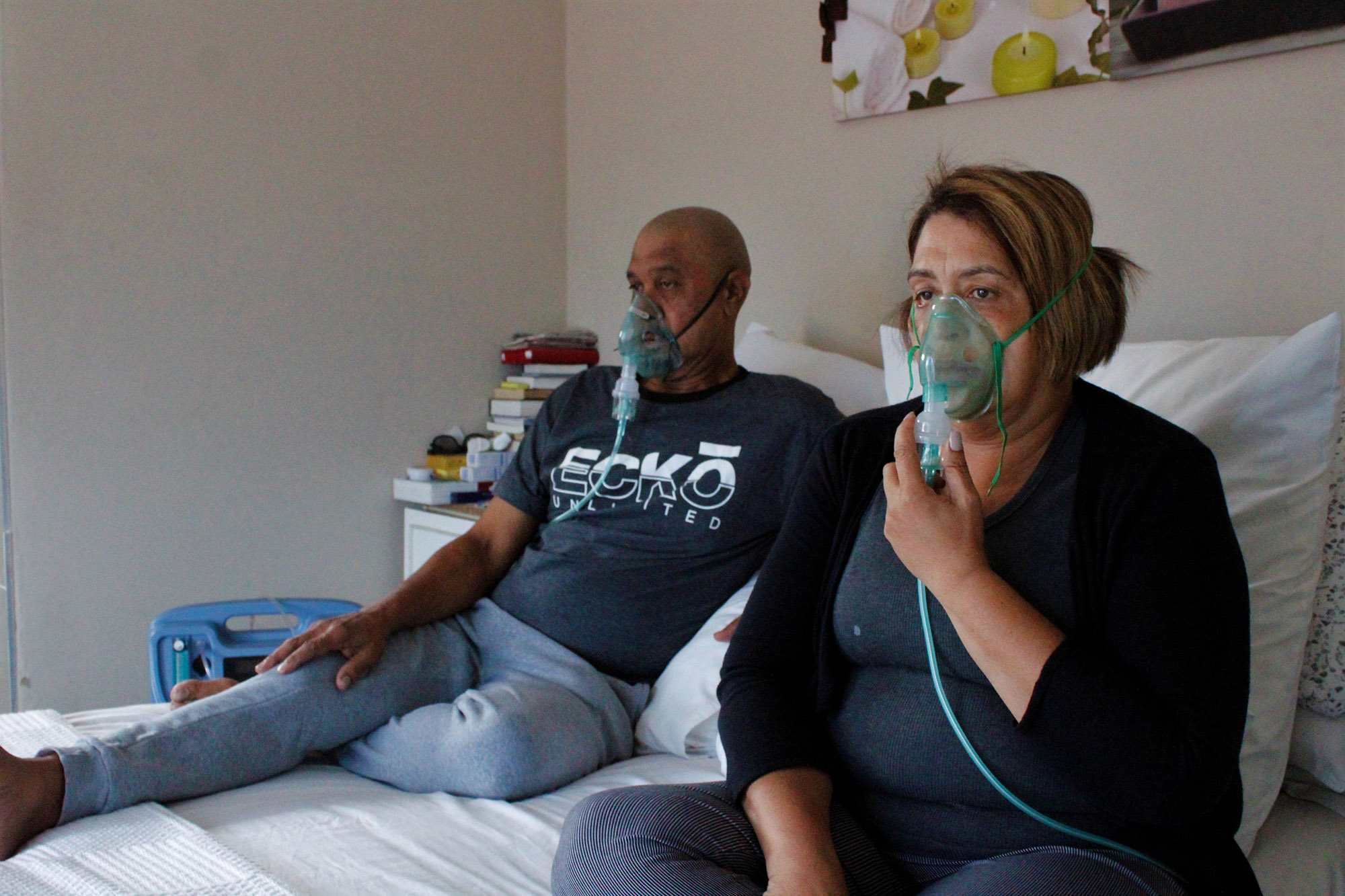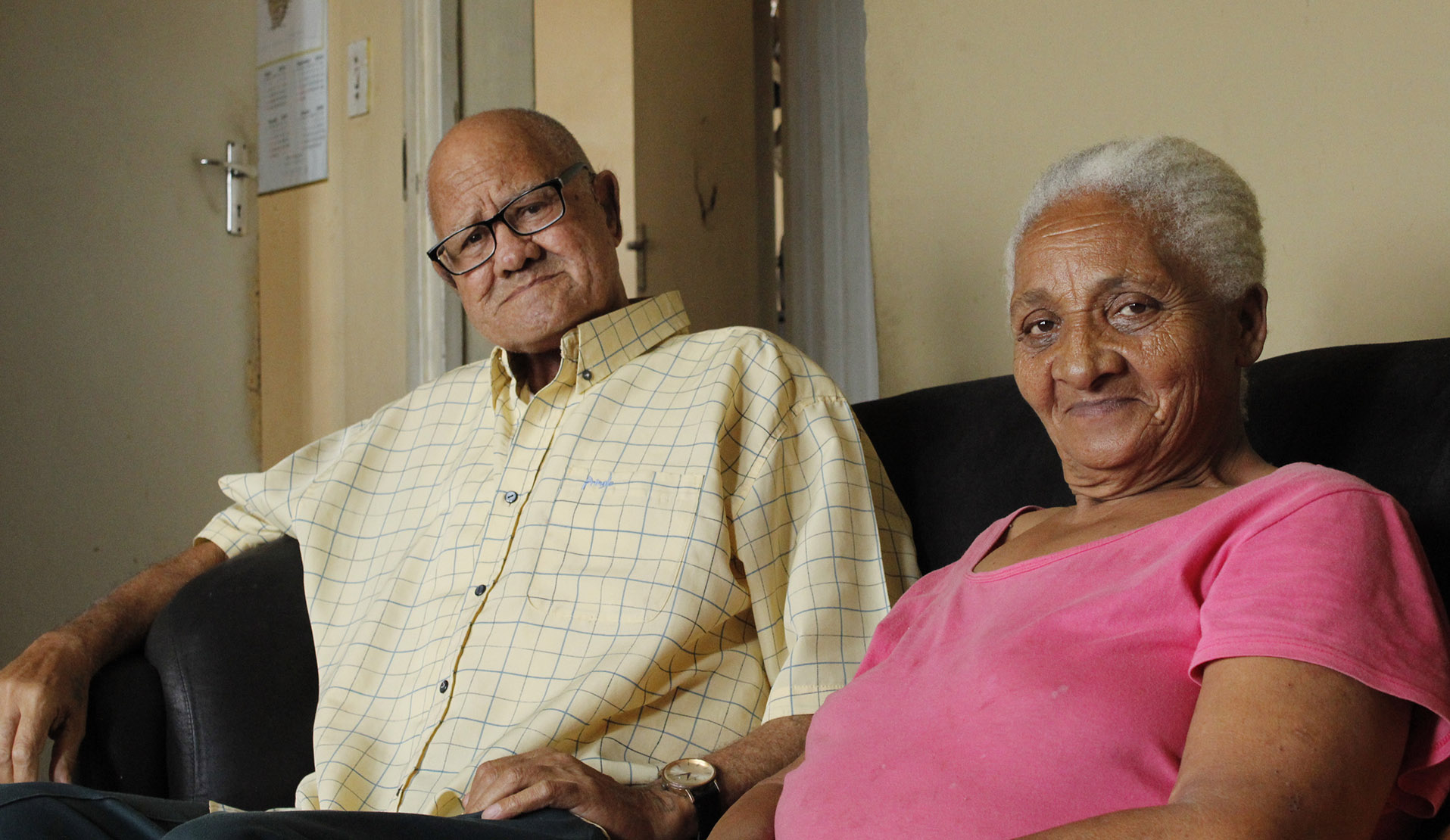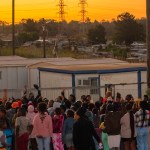
Stewart (59) and Romany Roberts (56) show their morning routine. (Photo: Nomfundo Xolo)“Our bedroom has become a hospital ward.” Romany Roberts says while she tries to find the third medicine bag.
Roberts, 56, and her husband, Stewart, 59, share an unusual morning routine: 10 minutes on the nebuliser, followed by assorted metered dose inhalers and boxes of pills.
The couple say their respiratory health deteriorated alarmingly after the chemical fire at the Safripol refinery in Wentworth, Durban on 16 August 2019. Thousands of residents suffered respiratory complications and skin irritation after the blaze. While the toxic fumes from the fire may have dissipated, the effects still linger in many of the residents.
“My life hasn’t been the same since the fire. My asthma has flared up and I haven’t stopped coughing. I’ve seen the doctor more times than I have in my life and been admitted for the first time in 45 years. Both my husband and I survive through strong medication,” said Roberts.
Roberts runs a daycare centre at her home in Merewent, a few kilometres from Safripol’s firm. She said the medical treatment she now uses has been an ongoing costly affair.
“We’ve had to pay for medication out of our own pockets. Safripol hasn’t shown the people they affected with the noxious fumes any remorse. They only arranged for us to get to the hospitals, but they never paid for our medical bills. What are they saying to the people who cannot afford private treatment?” asked Roberts.
Bongani Mthembu, air quality officer for the environmental justice group, South Durban Community Environmental Alliance (SDCEA), said Therminol (diphenyl and biphenyl oxide) measured 50.2ppm on the day of the incident. He described these compounds as comparatively non-toxic, but dangerous at high volumes:
“Exposure to this vapour can cause irritation to the lower and upper respiratory tracts, headaches and burning eyes. Many residents’ lungs were acutely affected due to the high concentration of Therminol in the air. The toxic gas was in the air from around 3pm to 8pm. Also, the highly absorbent gas remained in people’s homes, clothes and furniture for at least a month after the incident which escalated more illnesses,” explained Mthembu.

Couple, Walfred (74), and Margaret van Zyl (70) have been married for 48 years. They remain worried about the unpaid medical bills and demand Safripol to compensate them. (Photo: Nomfundo Xolo)
Margaret Van Zyl, 70, said long-term impact has been disregarded by Safripol. Clearly upset, she describes the text messages from St Augustine’s Hospital demanding that she settle her unpaid medical bills.
“I’m worried sick now, I don’t have money to pay the hospital and I don’t know what will happen when I don’t pay it. I suffered from a rash that still hasn’t gone away. My husband’s coughing has worsened, the hospital identified an unknown substance in his chest, but we cannot access the X-ray disc from St Augustine’s to get further information at a public hospital,” explained Van Zyl.
Van Zyl and her husband, who cannot talk (due to a previous operation) have stayed at the Hime Street flats for the past 30 years. The units are adjacent to Safripol, which manufactures polyethylene terephthalate resin and polyester fibre. She said the company has not done enough to curb the long-term health effects caused by the chemical fire.
“We live right across them, even a mere visit to our homes to at least assess the damages to our homes would’ve made a difference. All our clothes, linen and walls reeked of fumes. We had to wash everything, using our own disinfectants without a single contribution from Safripol. For them, it’s business as usual, while people are still suffering,” said Van Zyl.
Safripol’s CEO, Nico van Niekerk, said they had done enough for the community and that “exposure to residents were all well within the minimum”.
“By early October 2019, the absence of any chronic or residual effects attributable to Therminol VP1 (TVP-1) exposure on 16th August 2019, was consistent with the low levels of exposure to residents found in air dispersion modelling, as well as the low level of toxicity of TVP-1 found on toxicological review,” said Van Niekerk.
Furthermore, Safripol said the “extensive toxicological review” of Therminol conducted by Dr Willie van Niekerk, concluded that “only acute reversible health impacts could be anticipated for community residents, as well as workers at Safripol and nearby workplaces to the north.”
SDCEA lobbies for environmental justice in the area. SDCEA’s co-ordinator Desmond D’sa said this was a clear case of “environmental discrimination”.
“The company, Safripol, has taken no accountability for the people who are still experiencing severe side-effects. It is apparent that they are taking this issue lightly because we are a marginalised, sidelined, poor community.
“We continue to take affidavits from the affected residents together with their medical records. We are working together with Richard and Spoor Inc to make the class suit stronger. We want to make an example of Safripol. Big companies in south Durban have been getting away with murder while pocketing millions; this needs to end,” said D’sa.
Safripol gave an assurance that no permanent harm was caused by the “vapour leak”.
“The intent around providing the clinics and hospital check-ups was to ensure that Safripol first and foremost supported the local community as well as assured all concerned that no permanent harm was caused by the vapour leak. However, as a company, we can’t take over the role of government clinics and hospitals that provide medication to the general public,” said Van Niekerk.
General practitioner Devan K Pillay, who headed the mobile clinic, said thousands of affected residents were treated for minor respiratory complications. He said many of the severe cases caused by Therminol resulted in chemical pneumonitis, all referred to nearby hospitals.
He said the mobile clinic and medication were made available for the Wentworth community from 16 August until 21 September 2019.

Kathy van Wyk (61), seated on her husband, Jack van Wyk’s favourite couch. She said this is where Jack spent his last days after he had been having difficulty breathing. He later died of lung cancer that was said to have been dormant. (Photo: Nomfundo Xolo)
Kathy van Wyk, 63, has been left distraught by the aftermath of the chemical fire. Her flat is just a few metres from Safripol.
Her husband Jack van Wyk died on 25 August 2019, a few weeks after the chemical fire.
Kathy believes exposure to the toxic fumes triggered his dormant lung cancer.
“We suspected nothing. He has never shown any concerning signs. On 16 August, the day of the fire, my husband came home to a cloud of sickening fumes. The whole area was fogged, and we couldn’t even see. We closed the windows, but that only made it worse as the smell stayed inside, suffocating us. But it was better than outside. Later that night, Jack seemed restless and couldn’t sleep. He stayed on the couch in our bedroom all night. He complained that his chest was tight.
Kathy said Jack was diagnosed with a chest infection on 17 August 2019 at the mobile clinic provided by Safripol. He was referred to St Augustine’s Hospital, but was denied medication and sent home. Soon after, Jack’s coughing and swelling worsened. He returned to the hospital and was later diagnosed with lung cancer.
Kathy said the doctor informed them that the cancer had been dormant for years, but they could not afford further treatment at the private hospital.
“On 19 August, he came back from work early. His entire face and arms were swollen and still struggling with his breathing. We rushed him to the hospital, where he was then told he had dormant cancer. We were told that we had to pay for the X-ray scans and further treatment, but we couldn’t afford it because it was Safripol that had taken us to the hospital. He moved from Isipingo Hospital and was then given a date for King Edward VIII Hospital. But he never made it for that date. The fumes may have aroused the dormant cancer, because a week later he died,” said Kathy.
Safripol disputes these claims. According to the company, only seven of the 1,668 residents affected were admitted to hospital by clinic doctors who were all discharged from the hospital “within a day or two”.
“Safripol has paid for the treatment of symptoms caused by the vapour leak. We cannot be held accountable for pre-existing health conditions – the public health service and personal healthcare providers are better equipped to deal with these cases,” said Safripol’s Van Niekerk.
Dr Pillay said Jack van Wyk had also been diagnosed with chemical pneumonitis:
“Jack arrived at the clinic and complained of chest pains. After a thorough examination it was clear that he had a lung infection. I referred his case to the hospital for an X-ray — the results showed a mass in his lungs. The mass tested positive for lung cancer, which he may have had for years,” Pillay said.
South Durban experiences high levels of air pollution and waste disposal problems from the factories in the area. The area is filled with low-cost housing and informal settlements that develop around industrial areas.
D’sa said that the pollution from companies such as Safripol continue to infringe on the environmental rights of poor populations. He said further that eThekwini municipality needed to “recognise the community”. SDCEA said it had been requesting an emergency plan for 10 years.
“As the chemical incident unfolded, it was apparent that there was no leadership from the municipality’s health department. They are yet to implement an emergency plan to safeguard the public from a major chemical incident,” D’sa said.
eThekwini Municipality acting head of communications Mandla Nsele said:
“The matter is still being investigated with the possibility of legal action being taken against the company in respect of breaches of their scheduled trade permit. The City also has a generic off-site emergency preparedness plan, focusing specifically on the off-site impacts that may be caused by major hazardous installations.
Nsele said the disaster management department would review the generic emergency preparedness plan to improve its effectiveness for residents near industrial factories. MC
Nomfundo Xolo is a freelance journalist based in Durban.





















 Become an Insider
Become an Insider